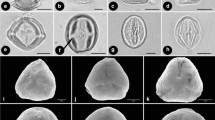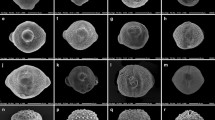Abstract
Data on pollen nuclear number are presented for 74 of the 111 currently accepted genera of theAraceae — one of only three monocot families in which both bi- and trinucleate pollen are known to occur. Binucleate pollen, which characterizes 65% of aroid genera, is regarded as the primitive type inAraceae and monocots as a whole. The trend toward the trinucleate condition appears to be irreversible, and to have occurred many times within the family.Syngonium becomes the sixth angiosperm genus in which both character-states are known to occur; otherwise, the character is highly conservative at the generic level. Pollen nuclear number shows no evident correlation with pollen size, starch content or pollinator type.
Similar content being viewed by others
Literature Cited
Brewbaker, J. L., 1967: The distribution and phylogenetic significance of binucleate and trinucleate pollen grains in the angiosperms. — Amer. J. Bot.54, 1069–1083.
Campbell, D. H., 1900: Studies on theAraceae. — Ann. Bot. (London)14, 1–25.
—— 1903: Studies on theAraceae. The embryo-sac and embryo ofAglaonema andSpathicarpa. — Ann. Bot. (London)17, 665–687.
Cocucci, A. E., 1966: Embriologia deSynandrospadix vermitoxicus. — Kurtziana3, 157–181.
Dudley, M. H., 1937: Morphological and cytological studies ofCalla palustris. — Bot. Gaz. (Crawfordsville)98, 556–571.
Duggar, B. M., 1900: Studies in the development of the pollen grain inSymplocarpus foetidus andPeltandra undulata. — Bot. Gaz. (Crawfordsville)29, 81–98.
Elfving, F., 1879: Studien über die Pollenkörner der Angiospermen. — Jenaische Z. Naturwiss.13, 1–28.
Engler, A., 1920:Araceae pars generalis et index familiac generalis, pp. 1–71. InEngler, A., (Ed.): Das Pflanzenreich74 (IV. 23. A). — Leipzig, Berlin.
Erdtman, G., 1960: The acetolysis method. A revised description. — Svensk Bot. Tidskr.54, 561–564.
Gardner, R. O., 1976: Binucleate pollen inTriglochin L. — New Zeal. J. Bot.14, 115–116.
Goldberg, B., 1941: Life history ofPeltandra virginica. — Bot. Gaz. (Crawfordsville)102, 641–662.
Gow, J. E., 1907: Morphology ofSpathyema foetida — Bot. Gaz. (Crawfordsville)43, 131–136.
—— 1913: Observations on the morphology of the aroids. — Bot. Gaz. (Crawfordsville)56, 127–142.
Grafl, I., 1940: Cytologische Untersuchungen anSauromatum guttatum. — Österr. Bot. Z.89, 81–118.
Grayum, M. H., 1984: Palynology and phylogeny of theAraceae. — Ph.D. diss. University of Massachusetts.
—— 1985: Evolutionary and ecological significance of starch storage in pollen of theAraceae. — Amer. J. Bot.72, 1565–1577.
Hanlon, J.-J., 1947: Cell division in the tapetum and the pollen mother cells ofSymplocarpus foetidus. — M. S. thesis, Fordham University.
Heslop-Harrison, J., 1976: The adaptive significance of the exine, pp. 27–37. — InFerguson, I. K., Muller, J., (Eds.): The Evolutionary Significance of the Exine. — London: Academic Press.
Hoekstra, F. A., Bruinsma, J., 1975: Respiration and vitality of binucleate and trinucleate pollen. — Physiol. Pl. (Copenhagen)34, 221–225.
Jos, J. S., Magoon, M. L., 1970: Pollen mitotic studies in some aroids. — Chromosome Info. Serv.11, 4–6.
Jüssen, F. J., 1929: Die Haploidgeneration der Araceen und ihre Verwertung für das System. — Bot. Jahrb. Syst.62, 155–283.
Leitner, J., 1942: Ein Beitrag zur Kenntnis der Pollenkörner derLabiatae. — Österr. Bot. Z.91, 29–40.
Maheshwari, P., 1949: The malc gametophyte of angiosperms. — Bot. Rev. (Lancaster)15, 1–75.
——, 1937: Recent advances in microtechnic. I. Methods of studying the development of the male gametophyte in angiosperms. — Stain Technol.12, 61–72.
Maheshwari, S. C., Khanna, P. P., 1956: The embryology ofArisaema wallichianum Hooker f. and the systematic position of theAraceae. — Phytomorphology6, 379–388.
Mascré, M., 1928: Sur le tapis staminal et le grain de pollen de l’Arum maculatum. — Compt. Rend. Hebd. Séances Acad. Sci.186, 1632–1644.
Mücke, M., 1908: Über den Bau und die Entwicklung der Früchte und über die Herkunft vonAcorus calamus L. — Bot. Zeitung (Berlin)66, 1–23.
Nicolson, D. H., Sivadasan, M., 1981: Four frequently confused species ofTyphonium Schott (Araceae). — Blumea27, 483–497.
Parameswaran, N., 1959: A contribution to the embryology ofTheriophonum minutum. — Proc. Indian Acad. Sci.50 B, 15–25.
Pickett, F. L., 1915: A contribution to our knowledge ofArisaema triphyllum. — Mem. Torrey Bot. Club16, 1–65.
Poddubnaja-Arnoldi, V., 1936: Beobachtungen über die Keimung des Pollens einiger Pflanzen. — Planta25, 502–529.
Schnarf, K., 1937: Studien über den Bau der Pollenkörner der Angiospermen. — Planta27, 450–465.
—— 1939: Variation im Bau der Pollenkörner der Angiospermen. — Tabulae Biol.17, 72–89.
Schürhoff, P. N., 1926: Die Zytologie der Blütenpflanzen. — Stuttgart: Ferdinand Enke.
Shadowsky, A. E., 1931: Einige Angaben über die Embryogenie vonPistia stratiotes L. — Ber. Deutsch. Bot. Ges.49, 350–356.
Stout, A. B., 1937: Some observations on flower behavior inAmorphophallus titanum. — J. New York Bot. Gard.38, 197–200.
Strasburger, E., 1884: Neue Untersuchungen über die Befruchtungsvorgänge bei den Phanerogamen. — Jena.
Vignoli, L., 1939: Gametofiti e cromosomi diAmbrosinia bassii L. — Lav. Reale Inst. Bot. Palermo10, 54–80.
Webster, G. L., Rupert, E. A., 1973: Phylogenetic significance of pollen nuclear number in theEuphorbiaceae. — Evolution27, 524–531.
—— ——, 1982: Systematic significance of pollen nuclear number inEuphorbiaceae, tribeEuphorbieae. — Amer. J. Bot.69, 407–415.
Author information
Authors and Affiliations
Rights and permissions
About this article
Cite this article
Grayum, M.H. Phylogenetic implications of pollen nuclear number in theAraceae . Pl Syst Evol 151, 145–161 (1986). https://doi.org/10.1007/BF02430271
Received:
Issue Date:
DOI: https://doi.org/10.1007/BF02430271




